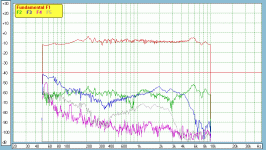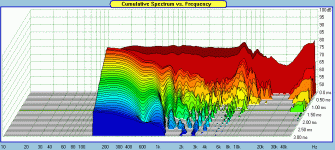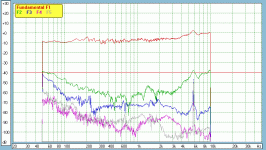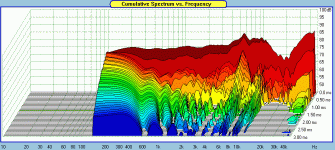Thanks, i see what you mean. Sadly my woofer isn't the most sensitive in the world though it does have much more power handling and Xmax than the others which ultimately means I can get higher SPL from it. I think as I'm using an active crossover it'd be easier to adjust the signal levels, I see theres a circuit on the ESP web site here which looks enormously simple if the input/output impedances suit it.that will usually be a 2.5way
(mostly a 2way with two identical woofers)
in a 3way its good practice to use a woofer with higher sensitivity that the mid
but BSC can be a very delicate balance act
its easy enough to attenuate a midrange
if you can live with that
but you really do not want to attenuate a woofer, in the common sense
but might be done by using very big inductor
though not very practical, and expencive
btw, box tuning could in some cases have some influence
Cheers
kev
Yes, a 4th order phase-coherent one, in theory. I'm hoping the active approach will make my life considerably easier, which is a prime aim for my first serious build, and also permit much cheaper/easier tweaking when i (inevitably) fail to get things quite right to begin with.Or 3.5 way.
But then again, aren't you going with an active crossover?
cheers
kev
Heh-heh, surely there's far more agonising to be had out of the mid range first...As long as your woofer has enough SPL capacity with BSC factored in, your baffle width is at least 12", and you're crossing @ 400hz, BSC shouldn't be an issue at all. Now let's pick a tweeter.
I'm not especially bothered about ultra-high frequencies, my hearing isn't that of an 18year old any more, but I would like reasonable off axis performance in the more audible frequencies. At the low end I'd want to cross over low enough to contain the off axis response of the mid too: if i went for the small 10F then maybe 3.5kHz would be okay, perhaps 3kHz for the HM100, 2.5kHz for some of the 15/5.25" options - down to 2kHz for anything bigger.
I liked the Hiquphon ones that Jonasz suggested but they are too expensive for me at the moment; I probably would be spending less on the bass driver. SB acoustics seem to have a couple of good 25mm tweeters, with very nice (though probably quite smoothed) FR charts. The SB26STCN gets to 15kHz before the off axis starts to plummet; it has an Fs of 960Hz, spl of 92.5dB@2.83V into 4ohm, and 120w handling above 2.6kHz (2nd order), plus due to the compact neo magnet a small 72mm bezel (allowing close positioning). The SB26STAC or STC with normal magnets and slightly bigger 100mm bezels have a lower Fs of 750Hz so are also attractive, albeit they're 1dB less sensitive. Their upper end off-axis roll off is a fraction poorer but also more gentle and natural looking >15kHz. I'd imagine that both could get down to 2.5kHz, although the latter (non-neo) would seem more comfortable at going low, with lower Fs and lower flat FR.
The SEAS 27TFFC is a tad bigger and has a Fs of just 550Hz so this one could run from about 2kHz. Its not massively different to the SBs in sensitivity but has lower power handling over the same 2.5kHz+ range, and less than half the Xmax. More immediately, the 60 degree off axis is considerably worse, its around -15dB and sinking near-vertically by 15kHz, whilst the larger SBs are only around -10dB and much shallower, the neo is even better.
So unless i want to run from 2kHz I'm thinking one of the SBs would be the best i've seen so far. In fact even though it has a higer Fs, with its greater Xmax, power handling and lower flat response, the larger diameter SB could even be better than the seas down to 2kHz.
How am I doing so far?
Cheers
Kev
Last edited:
Kev, with a floor standing speaker that is not a skinny little thing, the floor boundary effectively changes the environment back into 2pi space. This means that the woofer and the mid will not see the usual -6dB loss starting at the baffle step.
To get an accurate simulation of this, try the software that Face recommended, the Diffraction and Boundary Simulator. Set up your cab and driver parameters up top to get the baffle diffraction. Then also set up the Room Boundary Reinforcement parameters to isolate the floor gain only by putting in the height above the floor accurately but inputting 500" for the distances to the back and side walls. Turn the Room Pressurization Gain Calculation off and make sure you select the Axial Response in the bottom right hand corner of the Room Boundary Reinforcement chart. Sounds complicated but it isn't.
The bottom right hand chart, Combined Baffle Diffraction/Room Augmentation Summation will now give you an accurate depiction of the baffle diffraction and baffle step loss of your speaker.
To see this in practice, look closely at one of the speakers that tinitus mentioned as reference sources, 3-Way Classic or Jenzen CA for example. Follow the links to one of the woofers used, note it's sensitivity or it's FR graph, and then look at the sensitivity of the speaker, or in other words, the SPL output of the woofer in practice. There is no baffle step loss in the bottom end. In fact, you would not be incorrect to notice that there appears to be a very small gain. Look again at the diffraction and floor gain summation and you should see why.
Also, I know that you have found your way to Zaph|Audio, but I don't know if you have found the gift that all his measurements provide in terms of providing objective data to help you select drivers that you have never heard and are never likely to hear before you buy them. See his blog as well as his Current Driver Tests section.
I can also personally highly recommend the 5" Scan 15W8530K00 as a high end mid. Well worth the price of 2 x 10F's. I have it crossed at 2400Hz. http://www.solen.ca/pdf/scan/15w8530k00.pdf. Seems to be getting harder to find these days though.
Haven't used it but, in particular for its very linear off-axis response, you might want to look at this ribbon tweeter, the Fountek Neo Cd3.5H horn tweeter at The Madisound Speaker Store.
To get an accurate simulation of this, try the software that Face recommended, the Diffraction and Boundary Simulator. Set up your cab and driver parameters up top to get the baffle diffraction. Then also set up the Room Boundary Reinforcement parameters to isolate the floor gain only by putting in the height above the floor accurately but inputting 500" for the distances to the back and side walls. Turn the Room Pressurization Gain Calculation off and make sure you select the Axial Response in the bottom right hand corner of the Room Boundary Reinforcement chart. Sounds complicated but it isn't.
The bottom right hand chart, Combined Baffle Diffraction/Room Augmentation Summation will now give you an accurate depiction of the baffle diffraction and baffle step loss of your speaker.
To see this in practice, look closely at one of the speakers that tinitus mentioned as reference sources, 3-Way Classic or Jenzen CA for example. Follow the links to one of the woofers used, note it's sensitivity or it's FR graph, and then look at the sensitivity of the speaker, or in other words, the SPL output of the woofer in practice. There is no baffle step loss in the bottom end. In fact, you would not be incorrect to notice that there appears to be a very small gain. Look again at the diffraction and floor gain summation and you should see why.
Also, I know that you have found your way to Zaph|Audio, but I don't know if you have found the gift that all his measurements provide in terms of providing objective data to help you select drivers that you have never heard and are never likely to hear before you buy them. See his blog as well as his Current Driver Tests section.
I can also personally highly recommend the 5" Scan 15W8530K00 as a high end mid. Well worth the price of 2 x 10F's. I have it crossed at 2400Hz. http://www.solen.ca/pdf/scan/15w8530k00.pdf. Seems to be getting harder to find these days though.
Haven't used it but, in particular for its very linear off-axis response, you might want to look at this ribbon tweeter, the Fountek Neo Cd3.5H horn tweeter at The Madisound Speaker Store.
Ah, most interesting - thanks very much for the very detailed reply, I'll have to have a go with the software. I'd also been looking at Tinitus' examples but hadn't quite grasped that aspect of them - thanks for helping me understand 
Yes Zaphs site has been quite interesting, though many of the drivers aren't easily available here quite a few are. Theres probably quite a lot of information there that passes me by, really, though i'm learning more about interpreting the measurements every time I visit. At the moment at least, I'm still relying on people's opinion as much as the factual measurements lest i interpret something wrongly, or fail to understand how it translates into audible performance, but its very reassuring when they coincide.
Thanks also for the recommendation on the 15W8530K00; I've been looking at the data sheet a lot as it certainly seems to do what I want but as usual was a bit nervous about my ability to judge its performance without real world feedback from people; I guess its just at a slightly less common price point.
That would be a very attractive proposition actually, as the others I'm considering all seem to have at least one aspect (fs, xmax, power handling, dispersion) which is a bit too close for comfort in my proposed role. I'm sure this wouldn't challenge some people, but as i get more into things I'm coming to feel that I should really try to avoid complications if i'm going to be successful at my level of experience.
Thanks again
Kev
Yes Zaphs site has been quite interesting, though many of the drivers aren't easily available here quite a few are. Theres probably quite a lot of information there that passes me by, really, though i'm learning more about interpreting the measurements every time I visit. At the moment at least, I'm still relying on people's opinion as much as the factual measurements lest i interpret something wrongly, or fail to understand how it translates into audible performance, but its very reassuring when they coincide.
Thanks also for the recommendation on the 15W8530K00; I've been looking at the data sheet a lot as it certainly seems to do what I want but as usual was a bit nervous about my ability to judge its performance without real world feedback from people; I guess its just at a slightly less common price point.
That would be a very attractive proposition actually, as the others I'm considering all seem to have at least one aspect (fs, xmax, power handling, dispersion) which is a bit too close for comfort in my proposed role. I'm sure this wouldn't challenge some people, but as i get more into things I'm coming to feel that I should really try to avoid complications if i'm going to be successful at my level of experience.
Thanks again
Kev
I don't know if this will be useful, but I'll give it a shot anyways. Warning - graphs to follow. 
One of the things that really helped me to understand some of the measurement data was to have a standard by which to make comparisons. For that, lets look at 4 reference level drivers, the Satori MW165DC, the ScanSpeak 15W8530K00, the B&W kevlar FST midrange from their 803D and the BG Neo10 planar driver.
First up is the Satori, probably one of the lowest distortion mid/woofers currently available (well, that doesn't cost an arm and a leg). In particular, you want to look at the 3rd (and to a lesser extent, the 5th) order harmonic distortion curves since these are more dissonant and therefore more offensive than the 2nd and 4th orders. Except for a few peaks, the blue curve (3rd order) is pretty much below the -80dB line between 100Hz and 10,000Hz. The next chart is the CSD graph (Cumulative Spectral Decay) which shows how fast the cone stops ringing across the frequency range. The 'mountains' show you where there are stronger resonances and the height - or more accurately, the rate of loss of height - shows you how long they last. So you can see that the cone rings more at LF than at HF but that the rapid loss in height shows it doesn't store a lot of energy.
With the Scan 15W, 3rd order is below -70dB from about 150Hz to 1200Hz telling you that's its optimal use is as a mid in a 3-way with a somewhat low xo point to the tweeter. CSD suggests optimal usage from 300 or 400Hz anywhere up to 20,000Hz.
For the B&W, 3rd order stays below -70dB from about 300Hz and descends downward to below -80dB at about 1800Hz, so this time, an excellent midrange from 300Hz to a higher xo point to the tweeter (I think they cross at about 4,000Hz). CSD shows some small resonances at about 3,000Hz and 5,000Hz but otherwise a very non-resonant cone material.
Next is the Neo10 planar. Except for couple a of peaks, 3rd order is again below -80dB from about 550Hz up to 10,000Hz. Optimally, this one is the most limited but will give outstanding performance above the higher woofer to mid xo point. Sorry, no CSD chart.
Of course, there are other important factors besides just these 2 types of measurements, including subjective opinions. Still, if I'm looking for a high end driver, these charts tell me that, in the band of frequencies in which I want to use the driver, I want the 3rd order harmonic distortion to be a minimum of about -70dB down on these charts. Measurements btw are taken at 96dB at 1/2 m.
So, here's how the Scan 10F-4424G00 stacks up (last 2 charts). Third order is below -70dB from about 300Hz all the way up. CSD is good, showing a very non-resonant cone. The Scan 15W has better distortion below about 300Hz and the 10F has better distortion above 1000Hz. So just very slightly different in these 2 realms.
Too bad Zaph never measured the Audaxes. If you look at their CSD's though, they are known for having very non-resonant cones (be sure to adjust for the Audax's different scales though when comparing).
One of the things that really helped me to understand some of the measurement data was to have a standard by which to make comparisons. For that, lets look at 4 reference level drivers, the Satori MW165DC, the ScanSpeak 15W8530K00, the B&W kevlar FST midrange from their 803D and the BG Neo10 planar driver.
First up is the Satori, probably one of the lowest distortion mid/woofers currently available (well, that doesn't cost an arm and a leg). In particular, you want to look at the 3rd (and to a lesser extent, the 5th) order harmonic distortion curves since these are more dissonant and therefore more offensive than the 2nd and 4th orders. Except for a few peaks, the blue curve (3rd order) is pretty much below the -80dB line between 100Hz and 10,000Hz. The next chart is the CSD graph (Cumulative Spectral Decay) which shows how fast the cone stops ringing across the frequency range. The 'mountains' show you where there are stronger resonances and the height - or more accurately, the rate of loss of height - shows you how long they last. So you can see that the cone rings more at LF than at HF but that the rapid loss in height shows it doesn't store a lot of energy.
With the Scan 15W, 3rd order is below -70dB from about 150Hz to 1200Hz telling you that's its optimal use is as a mid in a 3-way with a somewhat low xo point to the tweeter. CSD suggests optimal usage from 300 or 400Hz anywhere up to 20,000Hz.
For the B&W, 3rd order stays below -70dB from about 300Hz and descends downward to below -80dB at about 1800Hz, so this time, an excellent midrange from 300Hz to a higher xo point to the tweeter (I think they cross at about 4,000Hz). CSD shows some small resonances at about 3,000Hz and 5,000Hz but otherwise a very non-resonant cone material.
Next is the Neo10 planar. Except for couple a of peaks, 3rd order is again below -80dB from about 550Hz up to 10,000Hz. Optimally, this one is the most limited but will give outstanding performance above the higher woofer to mid xo point. Sorry, no CSD chart.
Of course, there are other important factors besides just these 2 types of measurements, including subjective opinions. Still, if I'm looking for a high end driver, these charts tell me that, in the band of frequencies in which I want to use the driver, I want the 3rd order harmonic distortion to be a minimum of about -70dB down on these charts. Measurements btw are taken at 96dB at 1/2 m.
So, here's how the Scan 10F-4424G00 stacks up (last 2 charts). Third order is below -70dB from about 300Hz all the way up. CSD is good, showing a very non-resonant cone. The Scan 15W has better distortion below about 300Hz and the 10F has better distortion above 1000Hz. So just very slightly different in these 2 realms.
Too bad Zaph never measured the Audaxes. If you look at their CSD's though, they are known for having very non-resonant cones (be sure to adjust for the Audax's different scales though when comparing).
Attachments
-
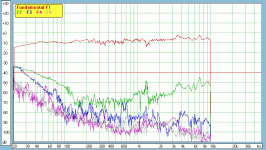 Satori-MW165DC-08N36-DA00-HD.gif24.3 KB · Views: 223
Satori-MW165DC-08N36-DA00-HD.gif24.3 KB · Views: 223 -
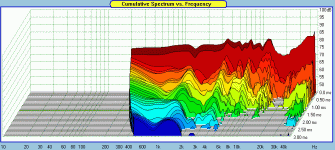 Satori-MW165DC-08N36-DA00-CSD.gif25.9 KB · Views: 214
Satori-MW165DC-08N36-DA00-CSD.gif25.9 KB · Views: 214 -
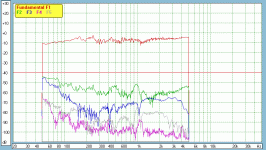 Scanspeak-15W8530K00-HD.gif20.5 KB · Views: 218
Scanspeak-15W8530K00-HD.gif20.5 KB · Views: 218 -
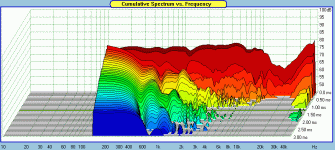 Scanspeak-15W8530K00-CSD.gif27 KB · Views: 211
Scanspeak-15W8530K00-CSD.gif27 KB · Views: 211 -
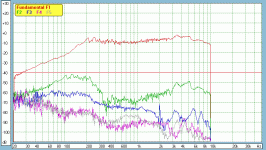 B&W-FST-LF00264-HD.gif22.4 KB · Views: 217
B&W-FST-LF00264-HD.gif22.4 KB · Views: 217 -
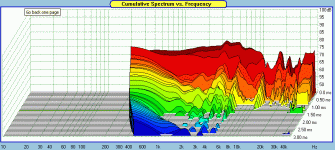 B&W-FST-LF00264-CSD.gif24.6 KB · Views: 60
B&W-FST-LF00264-CSD.gif24.6 KB · Views: 60 -
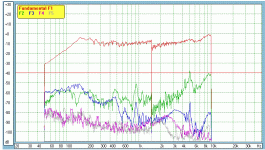 BG Neo10 HD.GIF29 KB · Views: 58
BG Neo10 HD.GIF29 KB · Views: 58 -
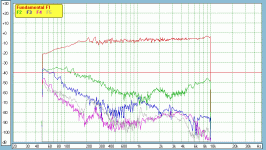 Scan-Speak-10F-4424G00-HD.gif21.1 KB · Views: 60
Scan-Speak-10F-4424G00-HD.gif21.1 KB · Views: 60 -
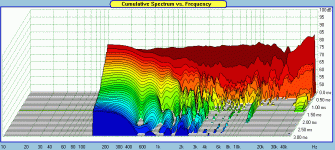 Scan-Speak-10F-4424G00-CSD.gif29.3 KB · Views: 57
Scan-Speak-10F-4424G00-CSD.gif29.3 KB · Views: 57
Just to be thorough, I think others have suggested the fiberglass Scan 15W8434G00, but it doesn't really measure quite as well as its smaller brother, the 10F.
If I was to stay in the 5" category and wanting to spend less money than the Revelators, I might go with the SB 15MFC30-8. The cone is a bit more resonant than the 8434 but its lower distortion shows that it has the better motor. You will have to pay attention to that resonance at about 6,000Hz though.
As a step up, and if I could live with a woofer/mid xo at around 400Hz - 500Hz, I'd go with the BG Neo8S which is the same as the above Neo10 but in a smaller size, but sorry, no charts available. Also don't know about European availablitity.
Scan 1st followed by the SB:
If I was to stay in the 5" category and wanting to spend less money than the Revelators, I might go with the SB 15MFC30-8. The cone is a bit more resonant than the 8434 but its lower distortion shows that it has the better motor. You will have to pay attention to that resonance at about 6,000Hz though.
As a step up, and if I could live with a woofer/mid xo at around 400Hz - 500Hz, I'd go with the BG Neo8S which is the same as the above Neo10 but in a smaller size, but sorry, no charts available. Also don't know about European availablitity.
Scan 1st followed by the SB:
Attachments
Superb! Many, many thanks for taking the time and effort to post all that - I believe that I actually understand what the graphs are saying about the drivers now, at least in a comparative sense. Invaluable 
Its also most useful with respect to the actual drivers (and alternatives) that I was considering. Far more to compare than I'd previously gleaned from just the simple FR charts I'd been relying on.
I understand the point that these charts aren't by themselves the entire picture, but thus far my evaluations have been quite heavily biased towards popular opinion - I intend to still listen to that of course, but now I'll be more able to consider it in the context of measured performance within my own intended ranges.
Many thanks once more!
Cheers
Kev
Its also most useful with respect to the actual drivers (and alternatives) that I was considering. Far more to compare than I'd previously gleaned from just the simple FR charts I'd been relying on.
I understand the point that these charts aren't by themselves the entire picture, but thus far my evaluations have been quite heavily biased towards popular opinion - I intend to still listen to that of course, but now I'll be more able to consider it in the context of measured performance within my own intended ranges.
Many thanks once more!
Cheers
Kev
Excellent Kev. Glad to be able to help.
There ends up being a lot of parameters by which the drivers can be evaluated and usually no 1 driver that is best in all of them. That's where the trade-offs come in - try to prioritize the ones that are most important to you and find the driver that excels at those. For you, it sounds like high SPL, a flat response so it's easier to work with, low harmonic distortion, a low resonant cone , I might add a good transient response and then there's that darn thing called money.
There ends up being a lot of parameters by which the drivers can be evaluated and usually no 1 driver that is best in all of them. That's where the trade-offs come in - try to prioritize the ones that are most important to you and find the driver that excels at those. For you, it sounds like high SPL, a flat response so it's easier to work with, low harmonic distortion, a low resonant cone , I might add a good transient response and then there's that darn thing called money.
Yes it does seem to be a bundle of compromises, so settling on my main criteria sounds like a very good idea; those you list do seem to describe what I'm after 
Were I to have unlimited funds this would be a very different project! Though even then i realise not an answer in itself. But I guess within reason the budget is at least slightly under my control; I won't be able to afford anything exotic but given the total cost of all this, including all the amps and power supplies, I'd be willing to pay somewhat more for drivers than I'd originally intended 'if' they were more suitable in ways that increased my chances of success. So the revelator mids aren't out of the question, but (for example) spending £300 on each tweeter probably would be.
Cheers
kev
Were I to have unlimited funds this would be a very different project! Though even then i realise not an answer in itself. But I guess within reason the budget is at least slightly under my control; I won't be able to afford anything exotic but given the total cost of all this, including all the amps and power supplies, I'd be willing to pay somewhat more for drivers than I'd originally intended 'if' they were more suitable in ways that increased my chances of success. So the revelator mids aren't out of the question, but (for example) spending £300 on each tweeter probably would be.
Cheers
kev
Last edited:
Just to report a bit on further SPL measurements that i've been making. I've now had my SPL meter at my side for a number of evenings and its been quite interesting. In particular I've been impressed by the differences in music style.
In particular, I was listening to a male acapella group last night and the peaks are much higher and more substancial than many other types of music that I've compared. Of course, I was expecting this type of music/vocals to have a bigger crest factor, but what i wasn't expecting was for the peaks to be so meaty in an absolute SPL sense. I guess this is probably because the average SPL is fairly low so my perception leads me to play it at a highish volume - which then makes the peakier sections really quite loud. It didn't seem abnormally or unrealistically loud though; I could easily imagine they were really stood there singing live.
The frequencies involved in voices would be particularly relavent to the mid driver, and presumably the bass driver wouldn't be sharing the power very much in this case either, which may blow another theory of mine out of the window. So whilst I'm still happy that the mid doesn't need to sustain the power needed for these peak SPLs, it certainly needs to be able to reach them effortlessly and more frequently than I'd perhaps imagined. Sadly I doubt the needle on my meter is capable of describing the true peak even on its fast setting, but there were sections where it was hovering up towards 100dB really quite a lot, even though the average SPL seemed quite normal.
Cheers
kev
In particular, I was listening to a male acapella group last night and the peaks are much higher and more substancial than many other types of music that I've compared. Of course, I was expecting this type of music/vocals to have a bigger crest factor, but what i wasn't expecting was for the peaks to be so meaty in an absolute SPL sense. I guess this is probably because the average SPL is fairly low so my perception leads me to play it at a highish volume - which then makes the peakier sections really quite loud. It didn't seem abnormally or unrealistically loud though; I could easily imagine they were really stood there singing live.
The frequencies involved in voices would be particularly relavent to the mid driver, and presumably the bass driver wouldn't be sharing the power very much in this case either, which may blow another theory of mine out of the window. So whilst I'm still happy that the mid doesn't need to sustain the power needed for these peak SPLs, it certainly needs to be able to reach them effortlessly and more frequently than I'd perhaps imagined. Sadly I doubt the needle on my meter is capable of describing the true peak even on its fast setting, but there were sections where it was hovering up towards 100dB really quite a lot, even though the average SPL seemed quite normal.
Cheers
kev
Some excellent advice from jReave. The B&G 8S is the only one of the Neo range I haven't heard, but based on my experience with the 3, 8 (non S version) and the 10 it has the potential to be your best sounding option. I would suggest you have a word with Meniscus Audio in America about the 8S, either with the Neo 3 tweeter or possibly in combination with the CSS RT1 ribbon tweeter, ideally the square faceplate version to minimise the distance between the mid and tweeter diaphrams to give you the widest range of crossover options. I've found Meniscus to be unfailingly pleasant and helpful and their shipping costs to the UK very reasonable. Another very strong candidate for you is the Kairos kit, which uses the SB Sartori drivers in what looks like an excellent design from an experienced designer. The enclosures for the L26s could either be used as stands or as seperate stereo subs. Without spending quite a bit more money- if then- I doubt you could do better than these options in a relatively conventional three-way design.
Thanks very much for the additional suggestions; I'll have a look into them!
TBH I don't know much about the planar and ribbon type transducers and have somewhat shied away from them; I have a (possibly unfounded) belief that their vertical dispersion may be rather too limited for me and also had assumed shipping/import costs and effort would be a deal breaker, but maybe not. Certainly its something i should look into rather than just guessing or ignoring!
The Kairos kit looks interesting too; its not quite what i wanted to build 'as is', but it could certainly give me some ideas.
Cheers
kev
TBH I don't know much about the planar and ribbon type transducers and have somewhat shied away from them; I have a (possibly unfounded) belief that their vertical dispersion may be rather too limited for me and also had assumed shipping/import costs and effort would be a deal breaker, but maybe not. Certainly its something i should look into rather than just guessing or ignoring!
The Kairos kit looks interesting too; its not quite what i wanted to build 'as is', but it could certainly give me some ideas.
Cheers
kev
Hey man, I just wanted to give you some words of encouragement. All 3 of those drivers you've picked, the 2 audax and the 10F are *excellent* drivers and not ridiculously expensive either. I doubt you'll end up with a bad sounding speaker with any one of the three so don't worry about it too much. All three have excellent disperson and while the 5" is naturally a tad less than the two 4's I doubt you'll REALLY notice that much of a difference after the whole thing is said and done. The speaker design you've chosen, a 3 way with dedicated mid is a classic, it's a good one, and it's been around pretty much since the beginning of time audio-wise for a reason.
The crossover and cabinets are likely going to be the biggest hurdles to conquer. In my experience it's the cabinets that are the hardest part by far!!
What I'm trying to say is, I think it'll be best to just pick the "front runner" whatever it is at this point and move on from there and forget about this $80 midrange versus that $90 one, it's all going to come out in the wash. I suppose if it were me I'd go for the HM100Z0 because I've used audax in the past and been very impressed and I think the aerogel is a really neat material. I also happen to think the high freq is harder to get right than the low personally and I'd rather have a leg up on the high end and some more room to "play" up there. That said, the scanspeak is an excellent choice as well, again all three will leave you a wide range of options and paths to take. I like the idea of the 3 seperate cabinets, a great way to go for testing and experimenting at the beginning and it'll make building them a lot easier.
As far as choosing the midrange first or the tweeter or WHATEVER, hey, you've gotta start somewhere right! You get something wrong, you can always change it later right? You're on a good path, and we're all watching the thread with interest, cheers!
The crossover and cabinets are likely going to be the biggest hurdles to conquer. In my experience it's the cabinets that are the hardest part by far!!
What I'm trying to say is, I think it'll be best to just pick the "front runner" whatever it is at this point and move on from there and forget about this $80 midrange versus that $90 one, it's all going to come out in the wash. I suppose if it were me I'd go for the HM100Z0 because I've used audax in the past and been very impressed and I think the aerogel is a really neat material. I also happen to think the high freq is harder to get right than the low personally and I'd rather have a leg up on the high end and some more room to "play" up there. That said, the scanspeak is an excellent choice as well, again all three will leave you a wide range of options and paths to take. I like the idea of the 3 seperate cabinets, a great way to go for testing and experimenting at the beginning and it'll make building them a lot easier.
As far as choosing the midrange first or the tweeter or WHATEVER, hey, you've gotta start somewhere right! You get something wrong, you can always change it later right? You're on a good path, and we're all watching the thread with interest, cheers!
Thanks for the encouragement chaps 
And thanks for the dose of realism too; theres a tendency to be attracted by ever more expensive drivers, but some are way over the top for me at my stage and on my budget! With the individual amps etc this project will be costing hundreds so I won't skimp a few notes on the mid driver if it gets me what i want, but beyond that I should certainly keep a cap on it.
Its been interesting to see how price isn't necessarily a good guide actually, even within the decent brands, so I think I'm probably going to ignore it for the mid driver and just look at what meets my criteria best, though 'within reason' as I'd start to get twitchy if they looked like costing noticeably more than the bass drivers.
Cheers
Kev
And thanks for the dose of realism too; theres a tendency to be attracted by ever more expensive drivers, but some are way over the top for me at my stage and on my budget! With the individual amps etc this project will be costing hundreds so I won't skimp a few notes on the mid driver if it gets me what i want, but beyond that I should certainly keep a cap on it.
Its been interesting to see how price isn't necessarily a good guide actually, even within the decent brands, so I think I'm probably going to ignore it for the mid driver and just look at what meets my criteria best, though 'within reason' as I'd start to get twitchy if they looked like costing noticeably more than the bass drivers.
Cheers
Kev
Last edited:
but you can consider every bit of not used Xmax to be wasted energy
Only with overhung drivers.
- Status
- This old topic is closed. If you want to reopen this topic, contact a moderator using the "Report Post" button.
- Home
- Loudspeakers
- Multi-Way
- Choosing between three mid drivers
